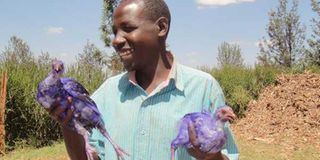Farmers discover painting chicken purple keeps away aerial predators

Geoffrey Mwangi at his home in Ruiru Village in Rongai Sub-County with some of his free range chicks painted purple. The colour camouflages the birds keeping confused aerial predators away. PHOTO | MORAA OBIRIA | NATION MEDIA GROUP
What you need to know:
- Mwangi has managed to maintain a brood of more than 100 chicken despite their exposure predators while feeding in the open.
- He uses the purple chicken dye to conceal the identity of his poultry from the many hawks ever hovering around his farm.
- Using the dye on the chicken is safe as it is organic and hence free from any harmful effects on either meat or eggs.
- Poultry farming continues to be attractive to many farmers in the country as the demand for the eggs and meat rises
As the demand for the indigenous poultry continues to rise farmers are finding ingenious ways of protecting their stock from predators.
And the chicken dye is coming quite in handy.
Some farmers in Nakuru County have embraced the camouflaging technique to keep their chicken from hawks’ talons preying during the day.
Geoffrey Mwangi is a happy farmer since he started using the dye in 2012.
He has managed to maintain a brood of more than 100 chicken despite their exposure predators while feeding in the open.
The small scale farmer from Ruiru in Rongai Sub-County, Nakuru uses the purple chicken dye to conceal the identity of his poultry from the many hawks ever hovering around his farm.
“From 2012 when I started painting the chicks, I have not lost any of them to the hawks,” says Mwangi.
He further explains: “The predators cannot recognize them since they resemble flowers or clothes. My only concern now is the Newcastle disease.”
WHOLE BROOD SURVIVES
Unlike before when he would hatch 50 chicks and loose half of them in a week to the predatory birds, now he says he is assured of a whole brood growing to maturity.
“I can comfortably keep my 160 chicks and six months later I have my complete stock to sell unless there is a disease outbreak like the rampant Newcastle,” he notes.
“It is such a relief from the many losses I made in the eight years I was in the business,” the farmer further states.
During festive seasons, he manages to sell off his poultry for a price ranging between Sh1,000 to Sh1,500 each.
A few metres away from Mwangi’s farm is Margaret Kimeria, with her 60 chicks painted in the colourful purple dye.
The colour disguises them into some kind of ornamental birds commonly kept as pets in homes or displayed in luxurious entertainment joints.
“I am no longer keeping vigil over the chicks. Previously it was a task for me to keep watch and scare off the hawks,” states Kimeria.
Ms Kimeria who rears the indigenous birds for commercial purposes says her attention has now shifted from replacing birds taken by predators to gradually increasing their numbers as she seeks to expand her customer base.
FREE RANGE CHICKEN REARING
“I want to have as many as I can since managing the chicken on free range is less laborious and there are enough termites for them to feed on. With the chicken dye, I am sure of an intact brood,” she asserts.
Painting the chicks with the dye involves using a mini-brush to roll the tint over the feathers.
According to Mwangi, who is also trained on application of the dye, the procedure should be done during the day under the sun.
“The dye is usually cold and the chicks are likely to die from cold. It should be applied under the sun so that they can bask,” says Mwangi.
He says the process of application is only repeatable if the feathers fall off as the dye does not fade away.
ORGANIC DYE SAFE
Using the dye on the chicken is safe as it is organic and hence free from any harmful effects on either meat or eggs according to Githui Kaba, a veterinary officer with the Ministry of Agriculture.
“The chicken dye is an organic paint. It is a food-based paint and not the kind made of normal chemicals or petroleum,” he says.
The officer says farmers are advised to camouflage the poultry reared in the free range system with a dye resembling the surrounding environment.
This makes it difficult for the predatory birds to single out the chicks from above.
Poultry farming continues to be attractive to many farmers in the country as the demand for the eggs and meat rises.





